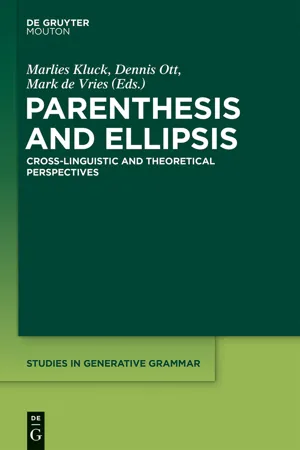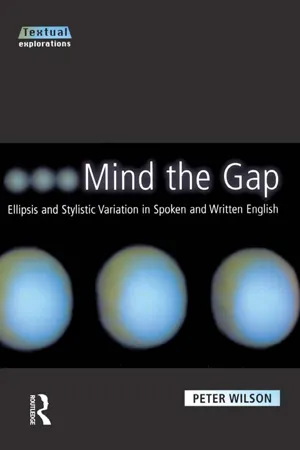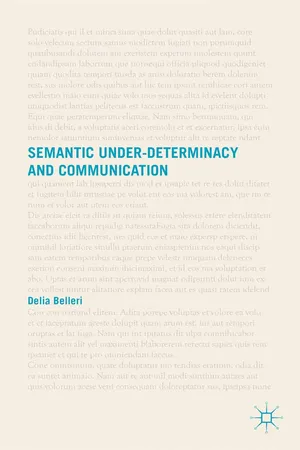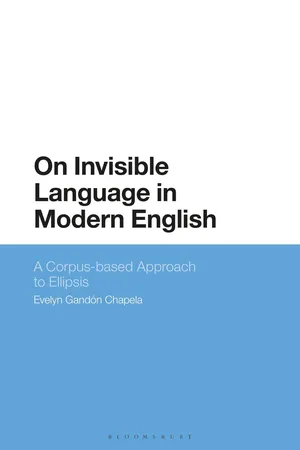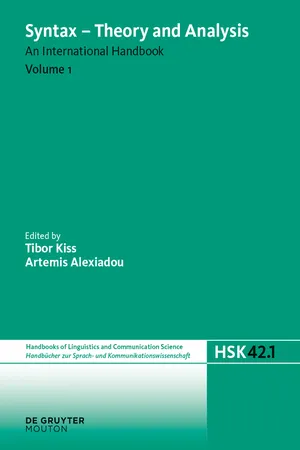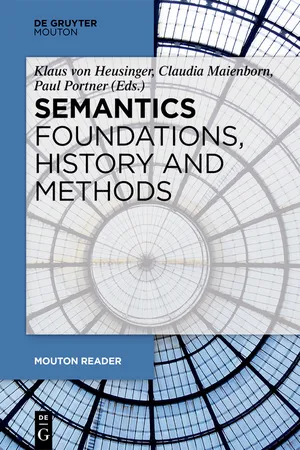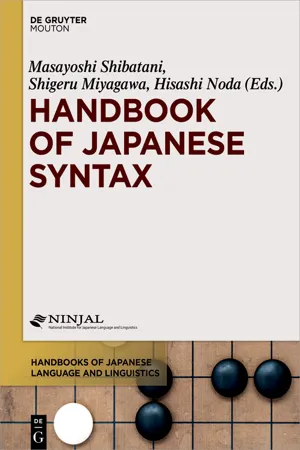Languages & Linguistics
Ellipsis
Ellipsis is a linguistic term that refers to the omission of words or phrases that are grammatically necessary but can be inferred from the context. It is commonly used in conversation and informal writing to avoid repetition and make speech more efficient. Ellipsis can occur in various forms, including verb phrase ellipsis, noun phrase ellipsis, and gapping.
Written by Perlego with AI-assistance
8 Key excerpts on "Ellipsis"
- eBook - ePub
Text Linguistics of Qur'anic Discourse
An Analysis
- Hussein Abdul-Raof(Author)
- 2018(Publication Date)
- Routledge(Publisher)
Ellipsis in Qur’anic discourse4.1 IntroductionThis chapter provides a comprehensive account of the text linguistic mechanism of Ellipsis in Qur’anic discourse. A detailed list of examples will be given to illustrate the three types of Ellipsis and their pragmatic functions. Among the major Ellipsis notions investigated are cataphoric and anaphoric Ellipsis, the four pragmatic functions of Ellipsis, the major types of Ellipsis (nominal Ellipsis and verbal Ellipsis), clausal Ellipsis, the relationship between Ellipsis and micro/macro intertextuality, Ellipsis and presupposition, and contextual Ellipsis. The sentences between brackets () represent non-elliptical (Ellipsis-free) sentences and are non-Qur’anic. The presupposed ellipted elements are placed between curly brackets {}.4.2 What is Ellipsis?Ellipsis is a Greek word meaning ‘to leave out’. Thus, Ellipsis is related to any word or phrase omitted from the sentence in order to avoid redundancy and produce an effective text structure. Ellipsis is a cohesive device which has a lexico-grammatical relation in which a word or a phrase is specified through the use of a grammatical signal, indicating that this word or phrase is to be recovered from what has gone before, i.e., to be retrieved from the preceding text (Halliday and Hasan 1976:308; Salkie 1995:57). In other words, Ellipsis is the leaving out of a word or a phrase instead of repeating the same word or phrase. Thus, there is a gap, but as readers, we can make sense of the ellipted (left out) items through the background information which we derive from the same, i.e., the previous, text or from the subsequent text we are reading. Therefore, Ellipsis is a form of anaphoric and cataphoric cohesion where we presuppose something by means of what is implied or unsaid.Ellipsis is a form of presupposition. In other words, it is a tool to specify someone/something through referring it to someone/something: - eBook - ePub
- Marlies Kluck, Dennis Ott, Mark de Vries, Marlies Kluck, Dennis Ott, Mark de Vries(Authors)
- 2014(Publication Date)
- De Gruyter Mouton(Publisher)
As I explained in the introduction, in many utterances, constructional patterns or constructions such as phrases, clauses or sentences can be observed. However, especially in spoken language, there are numerous utterances that do not completely adhere to these patterns, in which case they are incomplete or elliptical. Every utterance is as explicit as required by the context of the verbal interaction. Information that is clear from the linguistic and extralinguistic context does not need to be expressed. This principle of language economy is especially active in spoken language. The expression of information obvious from the context would make an utterance redundant and inappropriate. Hence, from the point of view of verbal interaction, an utterance is complete as long as the addressee’s comprehension is guaranteed.In contemporary linguistics, Ellipsis has been most extensively described from the perspective of formal syntax (e.g. by Johnson 2001; Merchant 2001; Lobeck 2006; Winkler 2006; Aelbrecht 2010). There, Ellipsis is usually defined quite narrowly. The context admitted for the interpretation of the silent string is constituted by the same sentence or the sentences in the surroundings of the elliptical sequence. In other words, there has to be a linguistic antecedent128 . For instance, Aelbrecht (2010: 11) states that “the Ellipsis site has to be recoverable by means of a salient linguistic antecedent”. This is one of the reasons why Ellipsis is frequently discussed in connection with structures, e.g., coordinated or similar structures, in which an antecedent can be identified unambiguously. In Winkler’s (2006: 109) overview of examples with gapping , verb phrase Ellipsis , pseudogapping , stripping , sluicing and noun phrase Ellipsis , the unexpressed strings can be recovered from the preceding clauses, mostly with their precise wording.Klein (1993: 766–768) adopts a different position on explicitness and Ellipsis. He distinguishes between Ellipsis under partial contextual control and Ellipsis under full contextual control129 - eBook - ePub
Mind The Gap
Ellipsis and Stylistic Variation in Spoken and Written English
- Peter Wilson(Author)
- 2014(Publication Date)
- Routledge(Publisher)
The most widespread term for many of the gaps that occur in language is ‘Ellipsis’. Although the term is defined and used in slightly different ways by different linguists, I am taking it as generic for the purposes of this book. The main aim just mentioned can accordingly be expressed as a simple question: what is Ellipsis? As is often the case with apparently simple questions, the answer proves to be less than straightforward. On the basis that exemplification is a good starting point for explanation, here is a clear-cut example of Ellipsis in everyday language, similar to one cited in the English National Curriculum document I referred to in the Introduction:A: What is the capital of England? B: London [ ]. In most conversational question-and-answer sequences, or contextual rejoinders as they are often referred to, we do not bother to encode information that can be understood from the linguistic context. This creates a gap, which I have indicated by an empty set of square brackets. In this case we know that B’s reply ‘means’ that ‘London [is the capital of England]’. The gap has been filled with material recoverable from the linguistic context, a process I most often refer to as expansion. Not all instances of Ellipsis are as simple and easily expanded as this one, however, and part of the aim of this book is to explore the range and complexity of the various types of gap identified.The status of Ellipsis as a linguistic phenomenon, its scope and range as a generic term, continues to be a matter of some debate within various branches of linguistics. Accordingly, this first part of the book provides a broad outline of Ellipsis according to various formal, contextual and situational criteria. The overall aim of this classification is descriptive adequacy, though relevant theoretical issues will be taken into account. The rationale for this study of Ellipsis is not, however, purely taxonomic. Elliptical features contribute to stylistic variation across a wide range of spoken and written genres. Therefore, another major aim of this book is to investigate how Ellipsis manifests itself as an exponent of various styles of speech and writing. Accordingly, Part Two - eBook - ePub
- D. Belleri(Author)
- 2014(Publication Date)
- Palgrave Macmillan(Publisher)
One might still think that semantically under-determined sentences are in some sense elliptical, but perhaps in a less syntactically laden sense. Perhaps the ellipticality at play here is something broader than the syntactic notion considered so far. Sentences like ‘The leaves are green’, ‘Jill is ready’ and so on may exhibit a ‘semantic Ellipsis’, that is an Ellipsis of content rather than of syntactic structure. This option has been already explored with regard to incomplete definite descriptions (‘the table’, ‘the horse’, ‘the house’) and indeed has had some distinguished proponents.Quine, for instance, states that our everyday use of descriptions is often elliptical, that is it leaves understood some parts of the condition to be satisfied by the denotatum of the description; as an example he cites ‘the yellow house’, which shortens the more complete description ‘the yellow house in the third block of Lee Street, Tulsa’ (Quine, 1940, p. 146). The same proposal is adopted by Sellars, who has it that utterances of sentences like ‘The table is large’ are often elliptical and are intended to state what would be non-elliptically stated by some more complete sentence, such as ‘The table over there is large’ (Sellars, 1954, p. 200).Both Quine and Sellars are careful in their phrasings: they both talk of elliptical uses or utterances. This may signal that what they have in mind is something different from strict syntactic Ellipsis; perhaps something more similar to abbreviation, or shorthand. Drawing from these terminological hints, Neale (2004, pp. 98–105) traces a distinction between syntactic Ellipsis, a genuinely linguistic phenomenon, and what he calls ‘utterance Ellipsis’, conceived as a mere way of using language. Syntactic Ellipsis, on the one hand, is the deletion of one or more sentential components, which can be easily recovered in the material antecedently articulated, thus allowing the reconstruction of the non-elliptical sentence via a ‘copy–paste’ process. Uttering a syntactically elliptical sentence implies engaging in an elliptical use. However, the reverse does not necessarily hold. This is because one can have mere Ellipsis of use - eBook - ePub
On Invisible Language in Modern English
A Corpus-based Approach to Ellipsis
- Evelyn Gandón-Chapela(Author)
- 2020(Publication Date)
- Bloomsbury Academic(Publisher)
The literature on Ellipsis within this framework has mainly focused on describing the characteristics of the existing elliptical phenomena across languages – and English is still by far the most studied language – as well as on trying to decipher what kind of relationship is established between an Ellipsis site and its antecedent, usually believed to be governed by some kind of parallelism. As highlighted by Merchant (2013a : 1), ‘It is no exaggeration to say that debates over the nature of this parallelism have formed the core of most of the Generative work on Ellipsis over the last forty years.’ The importance of these debates, as he argues, has to do with the fact that they are used in order to prove the preference for a particular kind of linguistic representation over another: Most of the debate is located in the arena of semantics and abstract syntactic structures – it is clear that surface syntactic or phonological parallelism is not at stake – and as such, elliptical structures often play an important role in fundamental ontological debates in linguistics. The logic is clear: if the parallelism or identity conditions found in Ellipsis resolution require reference to certain kinds of objects, then our theories of linguistic competence must countenance objects of that kind. [Merchant (2013a: 1)] Transformational Generative grammarians have been mainly concerned with trying to answer the following three questions (see Aelbrecht 2009, 2010 ; Bîlbîie 2011 ; Gallego 2011 ; Merchant 2013a): the structure question, the identity question and the licensing question. 18 In what follows, I will briefly describe the implications of the answers given to each of these questions - eBook - ePub
- Tibor Kiss, Artemis Alexiadou, Tibor Kiss, Artemis Alexiadou(Authors)
- 2015(Publication Date)
- De Gruyter Mouton(Publisher)
Apparently, the Ellipsis of the verb phrase is licensed in (2a), but not in (2b), nor in the Dutch or French examples in (3), even though the recoverability condition is fulfilled to the same extent in all these languages. In other words, there must be something in the syntax of these languages that determines whether or not a certain (recoverable) constituent can be elided. The question of what licenses Ellipsis syntactically is a long-standing one as well, starting with Sag (1976), Williams (1977) and Zagona’s (1982, 1988a, b) concept of an Ellipsis-licensing head. Lobeck’s (1995) approach works out the idea that Ellipsis is licensed in the same way as other (in her view) null pro ’s by the Empty Category Principle (ECP, Chomsky 1981). Merchant (2001) later introduces the E-feature for Ellipsis on the licensor, which has since been used and modified by many researchers (Aelbrecht 2010; van Craenenbroeck 2010; Gengel 2007a, 2008; among many others), and Thoms (2011) argues away from the notion of licensing heads and instead claims that Ellipsis is licensed by movement. Some of these developments are explored in section 6. 2. Elliptical phenomena: a quick overview As mentioned above, the term “Ellipsis” covers several phenomena in which there is a mismatch between sound and meaning. Before I go into the various analyses that are available for Ellipsis, I first illustrate some of the most common types with prototypical examples. Research on Ellipsis tends to name the different phenomena in a rather creative way, which can become confusing if one is not familiar with these names. The list I present is by no means exhaustive, and some types might very well be taken together, representing one and the same type, but it gives the interested reader a starting-point. 2.1 - eBook - ePub
- Klaus Heusinger, Claudia Maienborn, Paul Portner, Klaus Heusinger, Claudia Maienborn, Paul Portner(Authors)
- 2019(Publication Date)
- De Gruyter Mouton(Publisher)
Abstract: This paper shows how formal semantics emerged shortly after the explosion of interest in formally characterising natural language in the fifties, swiftly replacing all advocacy of semantic representations within explanations of natural-language meaning. It then charts how advocacy of such representations has progressively re-emerged in formal semantic characterisations through the need to model the systemic dependency on context of natural language construal. First, the logic concepts on which subsequent debates depend are introduced, as is the formal-semantics (model-theoretic) framework in which meaning in natural language is defined as a reflection of a direct language-world correspondence. The problem of context dependence is then set out which has been the primary motivation for introducing semantic representation, with sketched accounts of pronoun construal relative to context. It is also shown how, in addition to such arguments, proof-theoretic (hence structural) concepts have been increasingly used in semantic modelling of natural languages. Finally, Ellipsis is introduced as a novel window on context providing additional evidence for the need to advocate representations in semantic explanation. The paper concludes with reflections on how the goal of modelling the incremental dynamics of natural language interpretation forges a much closer link between competence and performance models than has hitherto been envisaged.1 Logic, formal languages, and the grounding of linguistic methodologies
The meaning of natural-language (NL) expressions, of necessity, is wholly invisible; and one of the few supposedly reliable ways to establish the interpretation of expressions is through patterns of inference. Inference is the relation between two pieces of information such that one can be wholly inferred from the other (if for example I assert that I discussed my analysis with at least two other linguists, then I imply I have an analysis, that I have discussed it with more than one linguist, and that I am myself a linguist). Inference alone is not however sufficient to pinpoint the interpretation potential of NL expressions. Essential to NL interpretation is the pervasive dependence of expressions on context for how they are to be understood, a problem which has been a driving force in the development of formal semantics. This article surveys the emergence of formal semantics following growth of interest in the formal characterisation of NL grammars (Chomsky 1955 , Lambek 1958 ). It introduces logic concepts on which subsequent debates depend and the formal-semantics framework (the formal articulation of what has been called truth-conditional semantics - eBook - ePub
- Masayoshi Shibatani, Shigeru Miyagawa, Hisashi Noda, Masayoshi Shibatani, Shigeru Miyagawa, Hisashi Noda(Authors)
- 2017(Publication Date)
- De Gruyter Mouton(Publisher)
The discussion so far suggests that Japanese has argument Ellipsis, N’-Ellipsis, and also sluicing if Takita (2012) is correct. Explanation for these phenomena must be sought and the theoretical consequences must be investigated. In this section, I will first suggest an analysis for argument Ellipsis and try to explain why it is observed in Japanese and Korean, but not, for example, in English. In the second part, I will raise the possibility to derive the generalization in (10), repeated below as (102), from Chomsky’s (2013, 2014) labeling algorithm.(102) Ellipsis: The complement of a functional category F (D, C, or T) can be elided only when F has a specifier, as illustrated below. The discussion in this section, like that in the preceding section, is exploratory. It raises more questions than it solves, but I hope it serves to clarify the kinds of theoretical issues that arise in the investigation of Ellipsis in Japanese.4.1Argument Ellipsis and the (Absence of) ɸ-feature Agreement
Argument Ellipsis is observed in Japanese and Korean but not in English, as the contrast between (103) and (104) shows.(104) a. John brought [DP his friend ]. b. * But Mary didn ’t bring [DP e]. It is proposed in Saito (2007) that this difference is related to the presence/absence of ɸ-feature agreement in those languages. In this subsection, I will briefly present this analysis as well as further issues it raises. As the analysis crucially assumes Chomsky’s (2000) proposal on ɸ-feature and Case valuation, I will first briefly go over this proposal.Chomsky (2000) maintains that Case is closely tied with ɸ-feature agreement. For example, the subject provides the ɸ-features of T (subject-verb agreement) and T specifies the Case of the subject as nominative. ɸ-feature agreement is nothing but the occurrence of the ɸ-features of a particular DP on a functional head. Then, it is necessary to specify how a functional head acquires ɸ-features from a DP. Chomsky proposes that this is accomplished by Agree as illustrated in (105b) for the v
Index pages curate the most relevant extracts from our library of academic textbooks. They’ve been created using an in-house natural language model (NLM), each adding context and meaning to key research topics.
Explore more topic indexes
Explore more topic indexes
1 of 6
Explore more topic indexes
1 of 4

